Comparative Analysis: Partnership and Joint Venture in Business Law
VerifiedAdded on 2020/04/21
|10
|1829
|56
Report
AI Summary
This report provides a detailed comparison of partnerships and joint ventures within the context of business and corporate law. It begins by defining both business structures, highlighting their key features, and outlining the relevant legislation governing them, specifically referencing the Partnership Act 1963 in Australia. The report then differentiates between partnerships and joint ventures, exploring their respective advantages and disadvantages, such as start-up costs, liability, flexibility, and the ability to gain new expertise or access new markets. The report concludes with a recommendation, suggesting that a partnership would be a more suitable structure for Xiaojing, Lance, and Nick's herbal product business. This recommendation is based on the flexibility and lower start-up costs associated with partnerships, making it a viable option for their business. The report uses various sources such as Austlii, Business.gov.au and Legal Vision to support the findings and recommendations.

0Running head: BUSINESS AND CORPORATE LAW
Business and Corporate Law
Business and Corporate Law
Paraphrase This Document
Need a fresh take? Get an instant paraphrase of this document with our AI Paraphraser
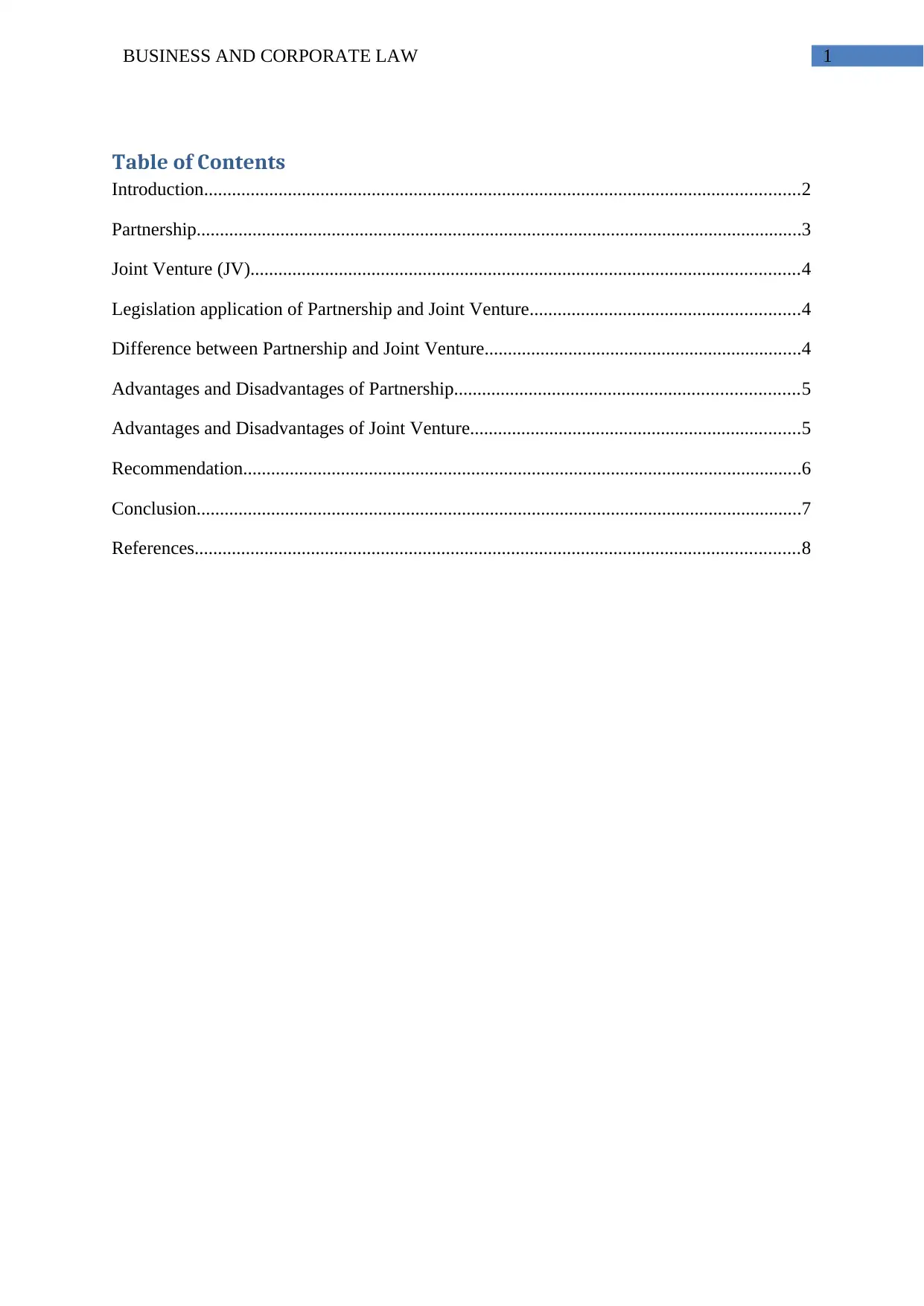
1BUSINESS AND CORPORATE LAW
Table of Contents
Introduction................................................................................................................................2
Partnership..................................................................................................................................3
Joint Venture (JV)......................................................................................................................4
Legislation application of Partnership and Joint Venture..........................................................4
Difference between Partnership and Joint Venture....................................................................4
Advantages and Disadvantages of Partnership..........................................................................5
Advantages and Disadvantages of Joint Venture.......................................................................5
Recommendation........................................................................................................................6
Conclusion..................................................................................................................................7
References..................................................................................................................................8
Table of Contents
Introduction................................................................................................................................2
Partnership..................................................................................................................................3
Joint Venture (JV)......................................................................................................................4
Legislation application of Partnership and Joint Venture..........................................................4
Difference between Partnership and Joint Venture....................................................................4
Advantages and Disadvantages of Partnership..........................................................................5
Advantages and Disadvantages of Joint Venture.......................................................................5
Recommendation........................................................................................................................6
Conclusion..................................................................................................................................7
References..................................................................................................................................8
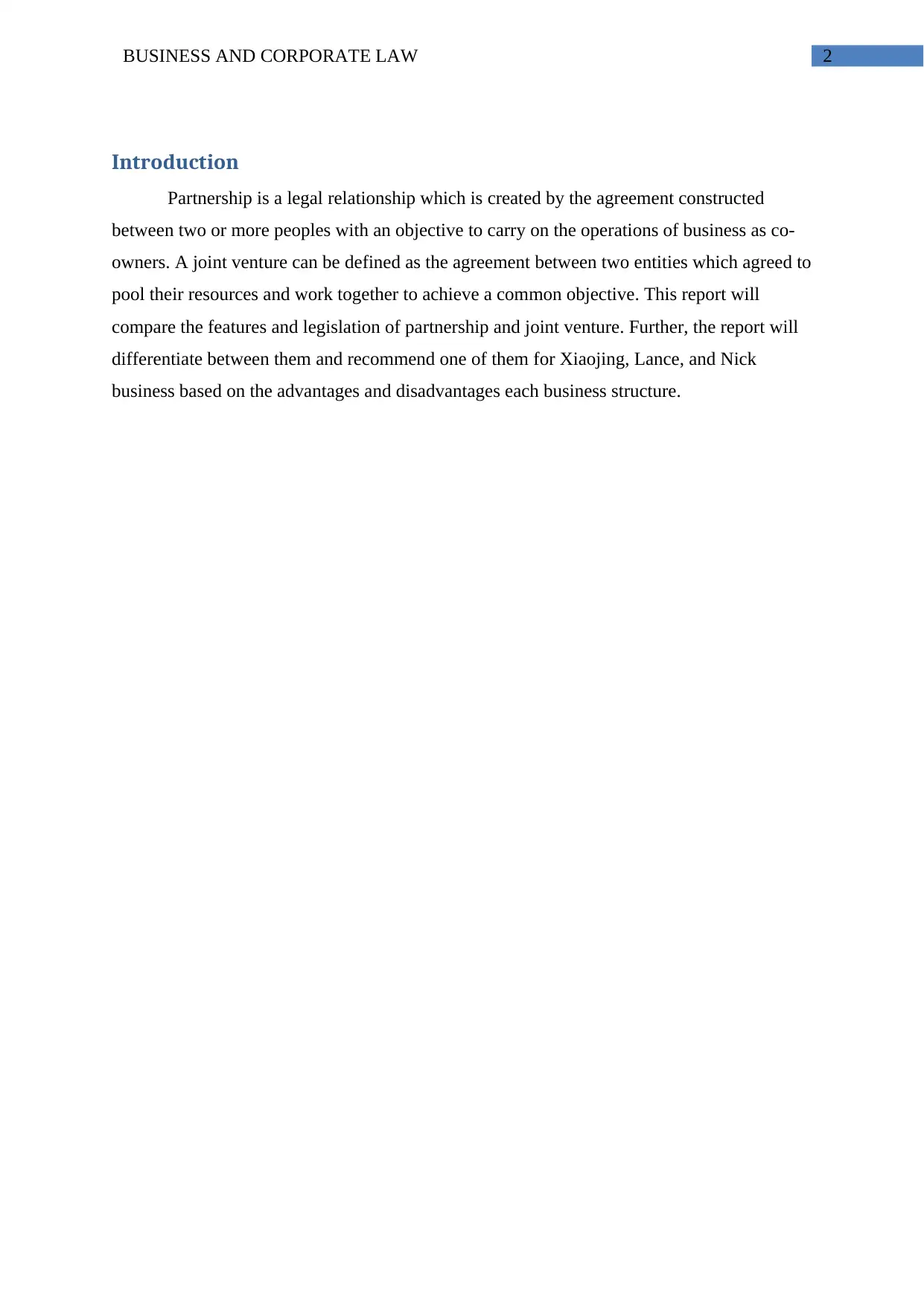
2BUSINESS AND CORPORATE LAW
Introduction
Partnership is a legal relationship which is created by the agreement constructed
between two or more peoples with an objective to carry on the operations of business as co-
owners. A joint venture can be defined as the agreement between two entities which agreed to
pool their resources and work together to achieve a common objective. This report will
compare the features and legislation of partnership and joint venture. Further, the report will
differentiate between them and recommend one of them for Xiaojing, Lance, and Nick
business based on the advantages and disadvantages each business structure.
Introduction
Partnership is a legal relationship which is created by the agreement constructed
between two or more peoples with an objective to carry on the operations of business as co-
owners. A joint venture can be defined as the agreement between two entities which agreed to
pool their resources and work together to achieve a common objective. This report will
compare the features and legislation of partnership and joint venture. Further, the report will
differentiate between them and recommend one of them for Xiaojing, Lance, and Nick
business based on the advantages and disadvantages each business structure.
⊘ This is a preview!⊘
Do you want full access?
Subscribe today to unlock all pages.

Trusted by 1+ million students worldwide
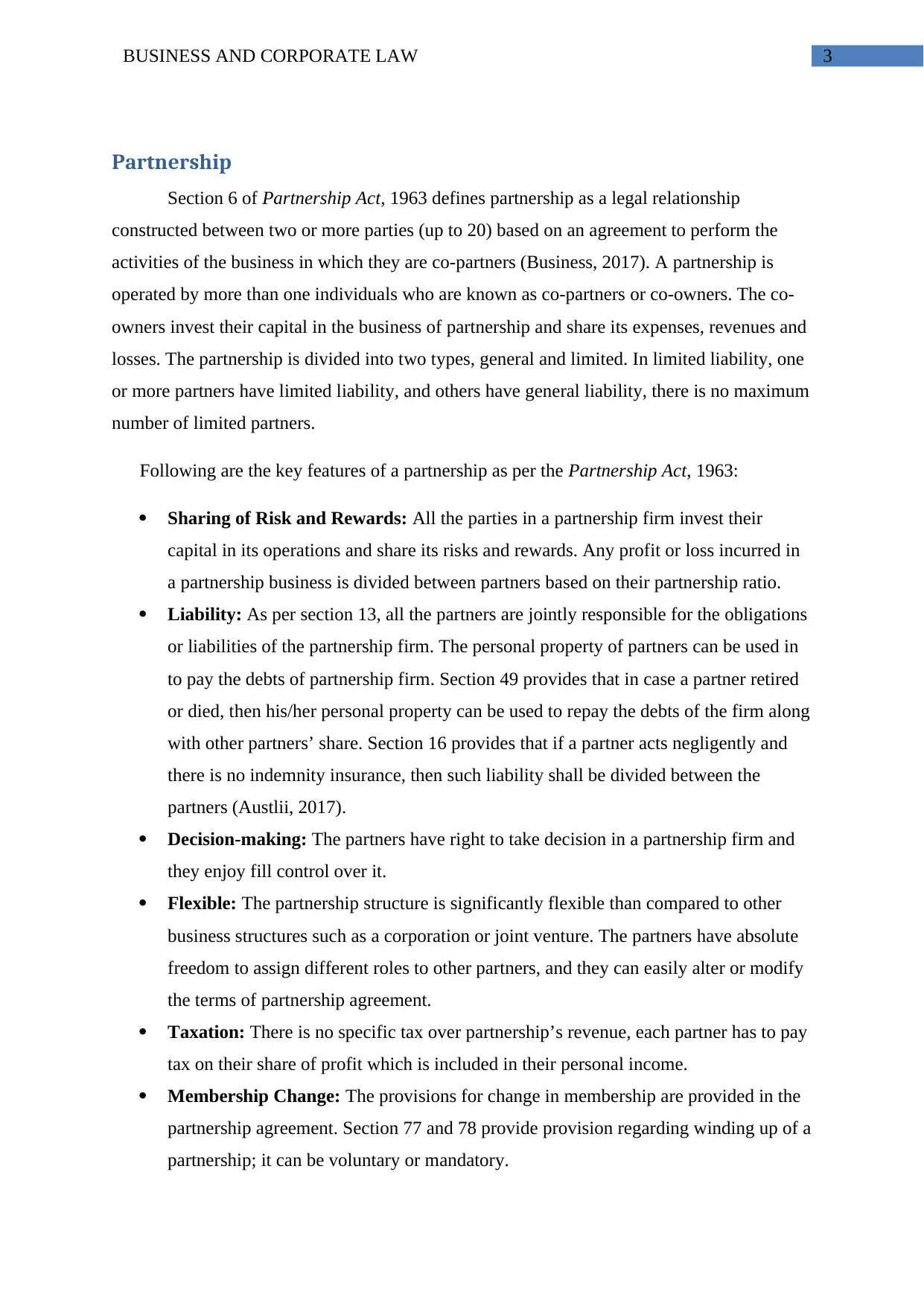
3BUSINESS AND CORPORATE LAW
Partnership
Section 6 of Partnership Act, 1963 defines partnership as a legal relationship
constructed between two or more parties (up to 20) based on an agreement to perform the
activities of the business in which they are co-partners (Business, 2017). A partnership is
operated by more than one individuals who are known as co-partners or co-owners. The co-
owners invest their capital in the business of partnership and share its expenses, revenues and
losses. The partnership is divided into two types, general and limited. In limited liability, one
or more partners have limited liability, and others have general liability, there is no maximum
number of limited partners.
Following are the key features of a partnership as per the Partnership Act, 1963:
Sharing of Risk and Rewards: All the parties in a partnership firm invest their
capital in its operations and share its risks and rewards. Any profit or loss incurred in
a partnership business is divided between partners based on their partnership ratio.
Liability: As per section 13, all the partners are jointly responsible for the obligations
or liabilities of the partnership firm. The personal property of partners can be used in
to pay the debts of partnership firm. Section 49 provides that in case a partner retired
or died, then his/her personal property can be used to repay the debts of the firm along
with other partners’ share. Section 16 provides that if a partner acts negligently and
there is no indemnity insurance, then such liability shall be divided between the
partners (Austlii, 2017).
Decision-making: The partners have right to take decision in a partnership firm and
they enjoy fill control over it.
Flexible: The partnership structure is significantly flexible than compared to other
business structures such as a corporation or joint venture. The partners have absolute
freedom to assign different roles to other partners, and they can easily alter or modify
the terms of partnership agreement.
Taxation: There is no specific tax over partnership’s revenue, each partner has to pay
tax on their share of profit which is included in their personal income.
Membership Change: The provisions for change in membership are provided in the
partnership agreement. Section 77 and 78 provide provision regarding winding up of a
partnership; it can be voluntary or mandatory.
Partnership
Section 6 of Partnership Act, 1963 defines partnership as a legal relationship
constructed between two or more parties (up to 20) based on an agreement to perform the
activities of the business in which they are co-partners (Business, 2017). A partnership is
operated by more than one individuals who are known as co-partners or co-owners. The co-
owners invest their capital in the business of partnership and share its expenses, revenues and
losses. The partnership is divided into two types, general and limited. In limited liability, one
or more partners have limited liability, and others have general liability, there is no maximum
number of limited partners.
Following are the key features of a partnership as per the Partnership Act, 1963:
Sharing of Risk and Rewards: All the parties in a partnership firm invest their
capital in its operations and share its risks and rewards. Any profit or loss incurred in
a partnership business is divided between partners based on their partnership ratio.
Liability: As per section 13, all the partners are jointly responsible for the obligations
or liabilities of the partnership firm. The personal property of partners can be used in
to pay the debts of partnership firm. Section 49 provides that in case a partner retired
or died, then his/her personal property can be used to repay the debts of the firm along
with other partners’ share. Section 16 provides that if a partner acts negligently and
there is no indemnity insurance, then such liability shall be divided between the
partners (Austlii, 2017).
Decision-making: The partners have right to take decision in a partnership firm and
they enjoy fill control over it.
Flexible: The partnership structure is significantly flexible than compared to other
business structures such as a corporation or joint venture. The partners have absolute
freedom to assign different roles to other partners, and they can easily alter or modify
the terms of partnership agreement.
Taxation: There is no specific tax over partnership’s revenue, each partner has to pay
tax on their share of profit which is included in their personal income.
Membership Change: The provisions for change in membership are provided in the
partnership agreement. Section 77 and 78 provide provision regarding winding up of a
partnership; it can be voluntary or mandatory.
Paraphrase This Document
Need a fresh take? Get an instant paraphrase of this document with our AI Paraphraser
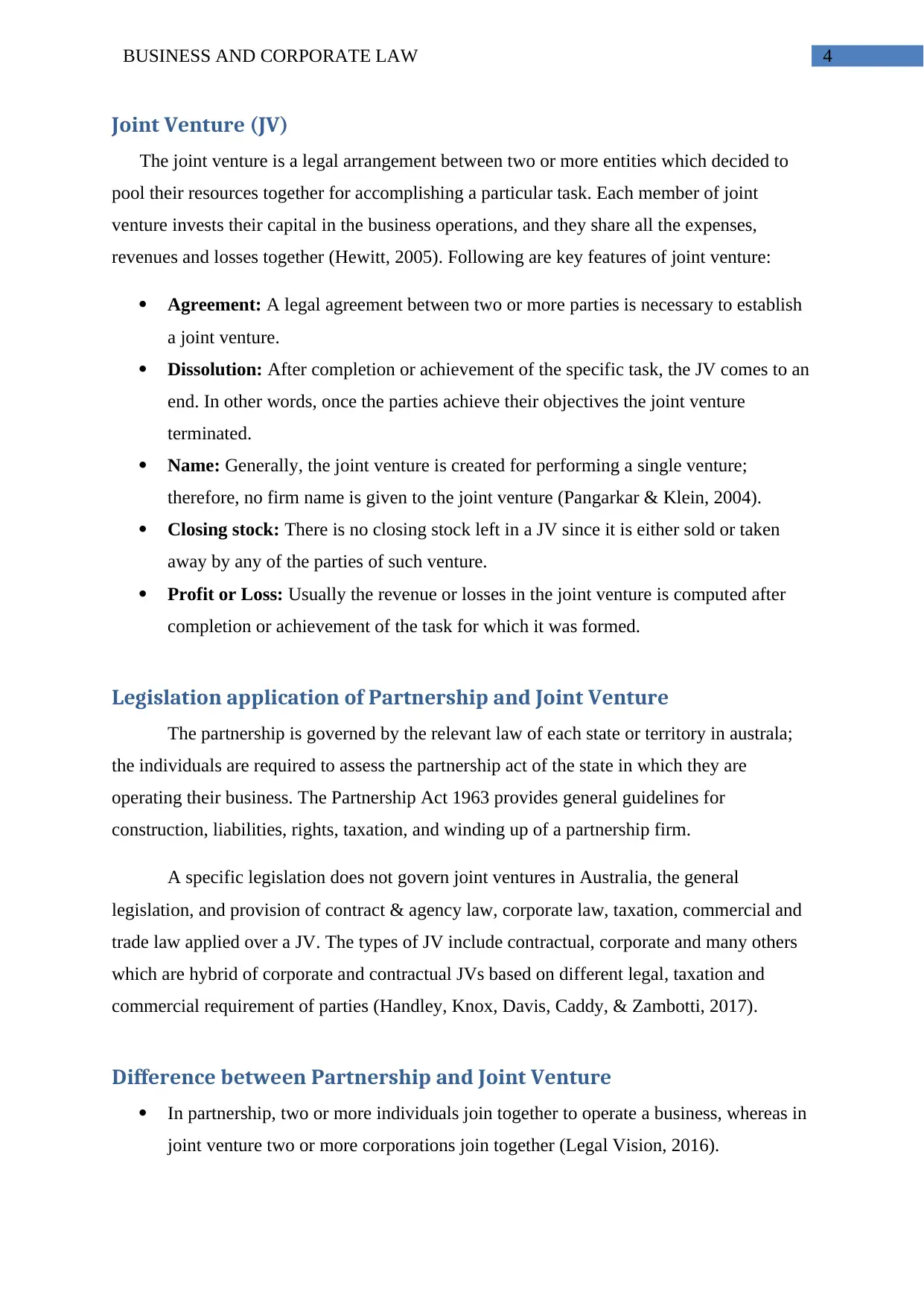
4BUSINESS AND CORPORATE LAW
Joint Venture (JV)
The joint venture is a legal arrangement between two or more entities which decided to
pool their resources together for accomplishing a particular task. Each member of joint
venture invests their capital in the business operations, and they share all the expenses,
revenues and losses together (Hewitt, 2005). Following are key features of joint venture:
Agreement: A legal agreement between two or more parties is necessary to establish
a joint venture.
Dissolution: After completion or achievement of the specific task, the JV comes to an
end. In other words, once the parties achieve their objectives the joint venture
terminated.
Name: Generally, the joint venture is created for performing a single venture;
therefore, no firm name is given to the joint venture (Pangarkar & Klein, 2004).
Closing stock: There is no closing stock left in a JV since it is either sold or taken
away by any of the parties of such venture.
Profit or Loss: Usually the revenue or losses in the joint venture is computed after
completion or achievement of the task for which it was formed.
Legislation application of Partnership and Joint Venture
The partnership is governed by the relevant law of each state or territory in australa;
the individuals are required to assess the partnership act of the state in which they are
operating their business. The Partnership Act 1963 provides general guidelines for
construction, liabilities, rights, taxation, and winding up of a partnership firm.
A specific legislation does not govern joint ventures in Australia, the general
legislation, and provision of contract & agency law, corporate law, taxation, commercial and
trade law applied over a JV. The types of JV include contractual, corporate and many others
which are hybrid of corporate and contractual JVs based on different legal, taxation and
commercial requirement of parties (Handley, Knox, Davis, Caddy, & Zambotti, 2017).
Difference between Partnership and Joint Venture
In partnership, two or more individuals join together to operate a business, whereas in
joint venture two or more corporations join together (Legal Vision, 2016).
Joint Venture (JV)
The joint venture is a legal arrangement between two or more entities which decided to
pool their resources together for accomplishing a particular task. Each member of joint
venture invests their capital in the business operations, and they share all the expenses,
revenues and losses together (Hewitt, 2005). Following are key features of joint venture:
Agreement: A legal agreement between two or more parties is necessary to establish
a joint venture.
Dissolution: After completion or achievement of the specific task, the JV comes to an
end. In other words, once the parties achieve their objectives the joint venture
terminated.
Name: Generally, the joint venture is created for performing a single venture;
therefore, no firm name is given to the joint venture (Pangarkar & Klein, 2004).
Closing stock: There is no closing stock left in a JV since it is either sold or taken
away by any of the parties of such venture.
Profit or Loss: Usually the revenue or losses in the joint venture is computed after
completion or achievement of the task for which it was formed.
Legislation application of Partnership and Joint Venture
The partnership is governed by the relevant law of each state or territory in australa;
the individuals are required to assess the partnership act of the state in which they are
operating their business. The Partnership Act 1963 provides general guidelines for
construction, liabilities, rights, taxation, and winding up of a partnership firm.
A specific legislation does not govern joint ventures in Australia, the general
legislation, and provision of contract & agency law, corporate law, taxation, commercial and
trade law applied over a JV. The types of JV include contractual, corporate and many others
which are hybrid of corporate and contractual JVs based on different legal, taxation and
commercial requirement of parties (Handley, Knox, Davis, Caddy, & Zambotti, 2017).
Difference between Partnership and Joint Venture
In partnership, two or more individuals join together to operate a business, whereas in
joint venture two or more corporations join together (Legal Vision, 2016).
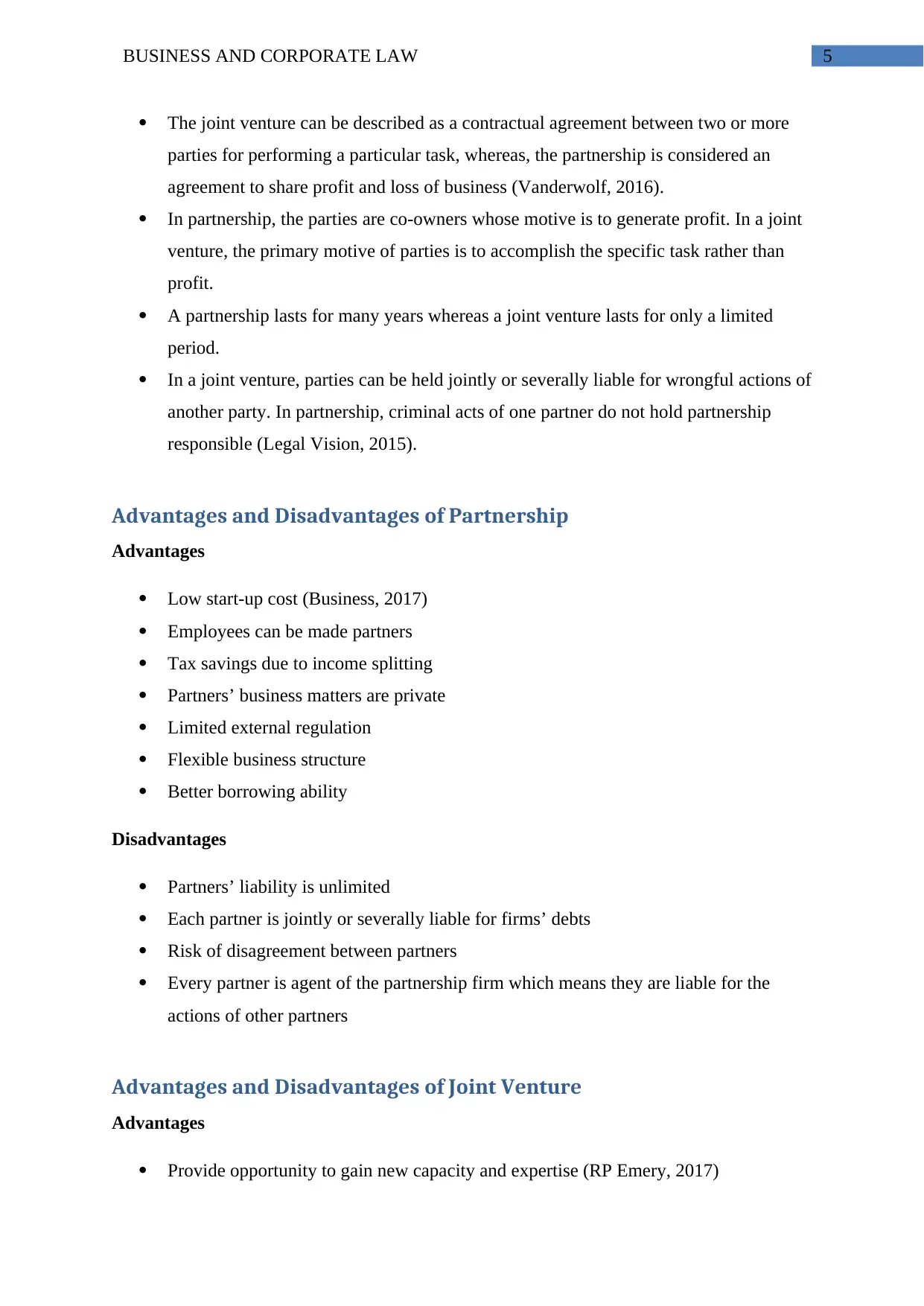
5BUSINESS AND CORPORATE LAW
The joint venture can be described as a contractual agreement between two or more
parties for performing a particular task, whereas, the partnership is considered an
agreement to share profit and loss of business (Vanderwolf, 2016).
In partnership, the parties are co-owners whose motive is to generate profit. In a joint
venture, the primary motive of parties is to accomplish the specific task rather than
profit.
A partnership lasts for many years whereas a joint venture lasts for only a limited
period.
In a joint venture, parties can be held jointly or severally liable for wrongful actions of
another party. In partnership, criminal acts of one partner do not hold partnership
responsible (Legal Vision, 2015).
Advantages and Disadvantages of Partnership
Advantages
Low start-up cost (Business, 2017)
Employees can be made partners
Tax savings due to income splitting
Partners’ business matters are private
Limited external regulation
Flexible business structure
Better borrowing ability
Disadvantages
Partners’ liability is unlimited
Each partner is jointly or severally liable for firms’ debts
Risk of disagreement between partners
Every partner is agent of the partnership firm which means they are liable for the
actions of other partners
Advantages and Disadvantages of Joint Venture
Advantages
Provide opportunity to gain new capacity and expertise (RP Emery, 2017)
The joint venture can be described as a contractual agreement between two or more
parties for performing a particular task, whereas, the partnership is considered an
agreement to share profit and loss of business (Vanderwolf, 2016).
In partnership, the parties are co-owners whose motive is to generate profit. In a joint
venture, the primary motive of parties is to accomplish the specific task rather than
profit.
A partnership lasts for many years whereas a joint venture lasts for only a limited
period.
In a joint venture, parties can be held jointly or severally liable for wrongful actions of
another party. In partnership, criminal acts of one partner do not hold partnership
responsible (Legal Vision, 2015).
Advantages and Disadvantages of Partnership
Advantages
Low start-up cost (Business, 2017)
Employees can be made partners
Tax savings due to income splitting
Partners’ business matters are private
Limited external regulation
Flexible business structure
Better borrowing ability
Disadvantages
Partners’ liability is unlimited
Each partner is jointly or severally liable for firms’ debts
Risk of disagreement between partners
Every partner is agent of the partnership firm which means they are liable for the
actions of other partners
Advantages and Disadvantages of Joint Venture
Advantages
Provide opportunity to gain new capacity and expertise (RP Emery, 2017)
⊘ This is a preview!⊘
Do you want full access?
Subscribe today to unlock all pages.

Trusted by 1+ million students worldwide
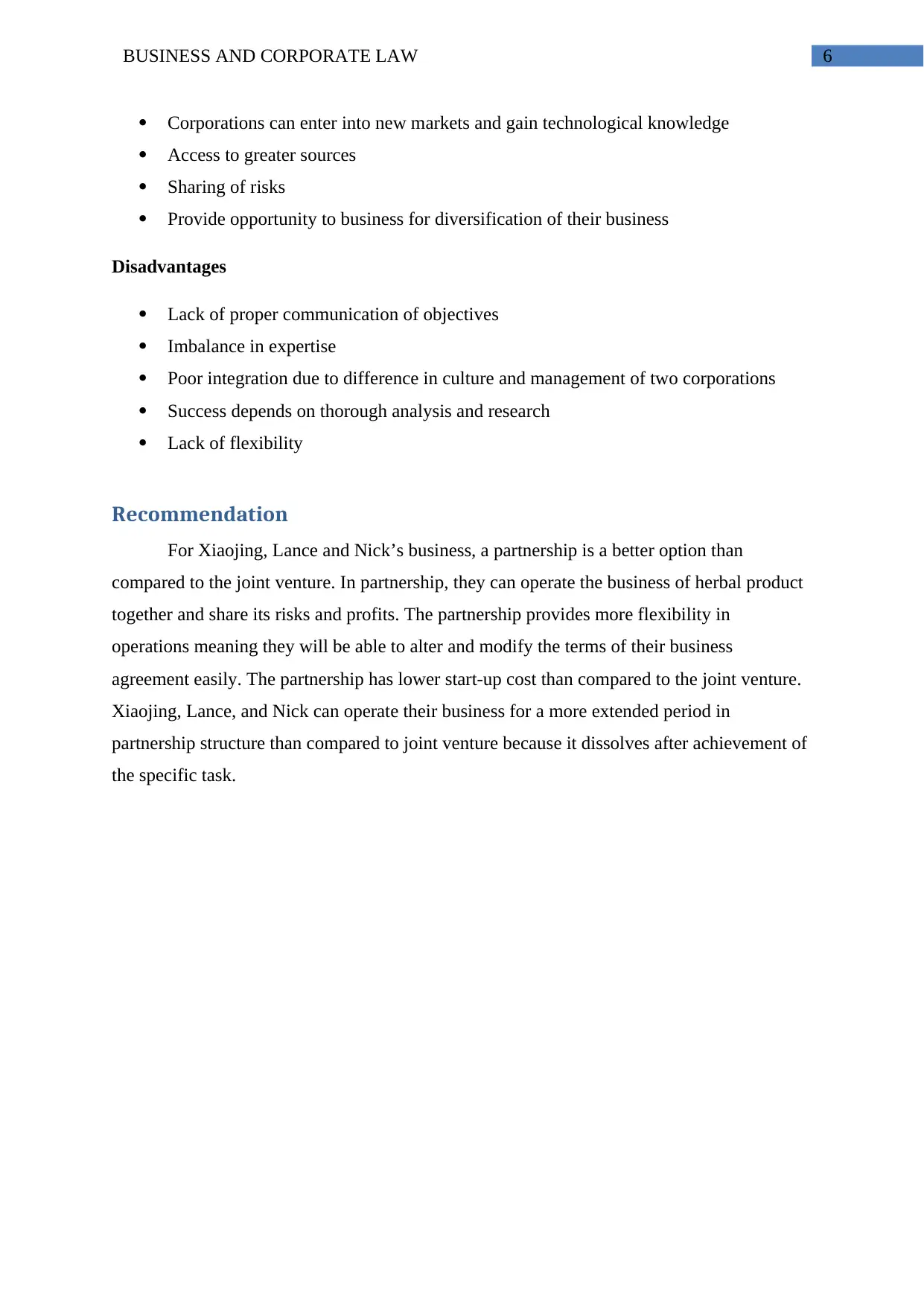
6BUSINESS AND CORPORATE LAW
Corporations can enter into new markets and gain technological knowledge
Access to greater sources
Sharing of risks
Provide opportunity to business for diversification of their business
Disadvantages
Lack of proper communication of objectives
Imbalance in expertise
Poor integration due to difference in culture and management of two corporations
Success depends on thorough analysis and research
Lack of flexibility
Recommendation
For Xiaojing, Lance and Nick’s business, a partnership is a better option than
compared to the joint venture. In partnership, they can operate the business of herbal product
together and share its risks and profits. The partnership provides more flexibility in
operations meaning they will be able to alter and modify the terms of their business
agreement easily. The partnership has lower start-up cost than compared to the joint venture.
Xiaojing, Lance, and Nick can operate their business for a more extended period in
partnership structure than compared to joint venture because it dissolves after achievement of
the specific task.
Corporations can enter into new markets and gain technological knowledge
Access to greater sources
Sharing of risks
Provide opportunity to business for diversification of their business
Disadvantages
Lack of proper communication of objectives
Imbalance in expertise
Poor integration due to difference in culture and management of two corporations
Success depends on thorough analysis and research
Lack of flexibility
Recommendation
For Xiaojing, Lance and Nick’s business, a partnership is a better option than
compared to the joint venture. In partnership, they can operate the business of herbal product
together and share its risks and profits. The partnership provides more flexibility in
operations meaning they will be able to alter and modify the terms of their business
agreement easily. The partnership has lower start-up cost than compared to the joint venture.
Xiaojing, Lance, and Nick can operate their business for a more extended period in
partnership structure than compared to joint venture because it dissolves after achievement of
the specific task.
Paraphrase This Document
Need a fresh take? Get an instant paraphrase of this document with our AI Paraphraser

7BUSINESS AND CORPORATE LAW
Conclusion
To conclude, the partnership can be defined as a legal relationship between two or
more individuals to operate a business and share its profits or losses. A joint venture is a legal
agreement between two or more corporations for combining their resources to accomplish a
specific task. For Xiaojing, Lance and Nick, the partnership is a better option than joint
venture due to its various benefits such as low start-up cost, limited external regulations,
flexible structure and it can be created for a more extended period than compared to a joint
venture.
Conclusion
To conclude, the partnership can be defined as a legal relationship between two or
more individuals to operate a business and share its profits or losses. A joint venture is a legal
agreement between two or more corporations for combining their resources to accomplish a
specific task. For Xiaojing, Lance and Nick, the partnership is a better option than joint
venture due to its various benefits such as low start-up cost, limited external regulations,
flexible structure and it can be created for a more extended period than compared to a joint
venture.
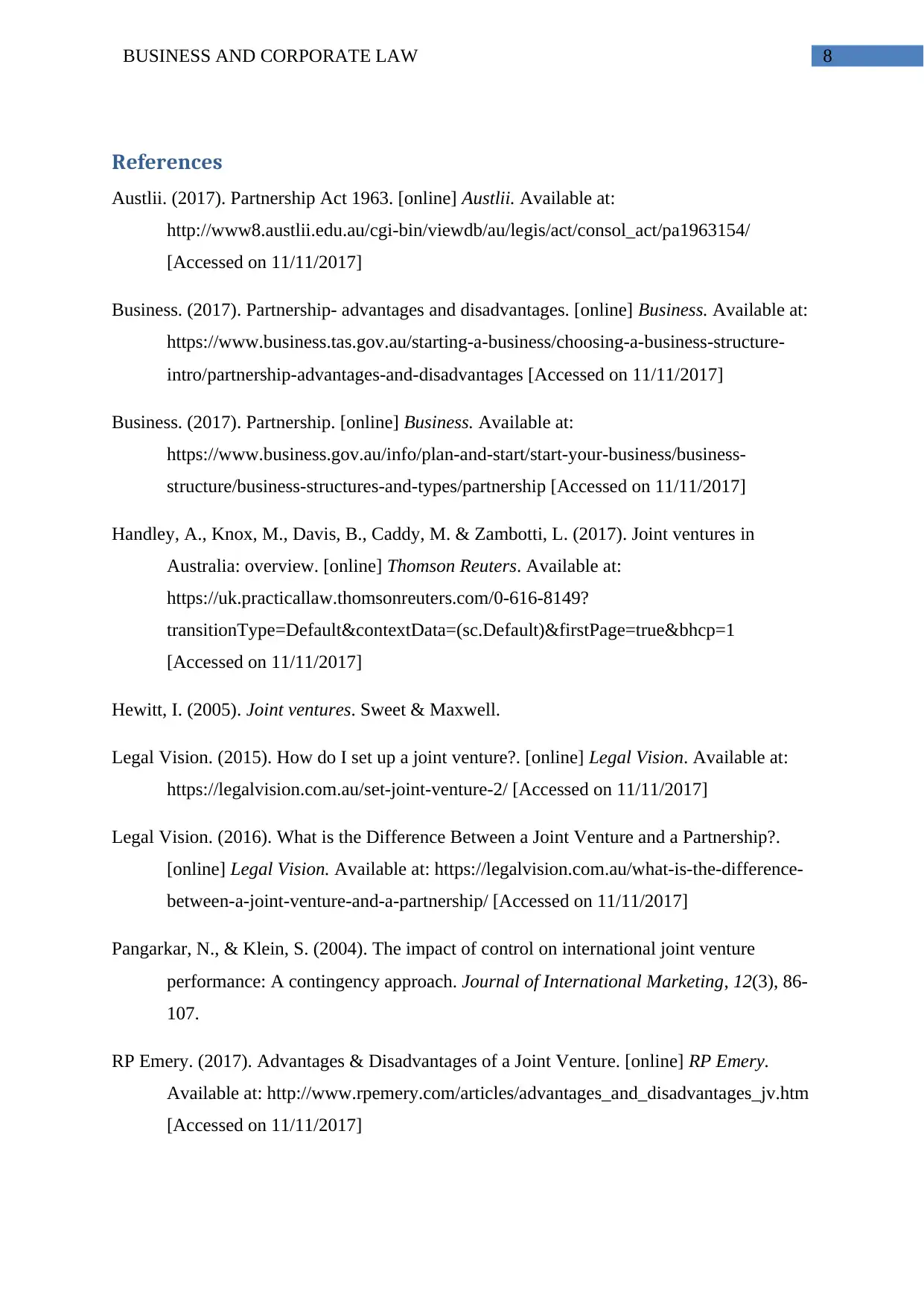
8BUSINESS AND CORPORATE LAW
References
Austlii. (2017). Partnership Act 1963. [online] Austlii. Available at:
http://www8.austlii.edu.au/cgi-bin/viewdb/au/legis/act/consol_act/pa1963154/
[Accessed on 11/11/2017]
Business. (2017). Partnership- advantages and disadvantages. [online] Business. Available at:
https://www.business.tas.gov.au/starting-a-business/choosing-a-business-structure-
intro/partnership-advantages-and-disadvantages [Accessed on 11/11/2017]
Business. (2017). Partnership. [online] Business. Available at:
https://www.business.gov.au/info/plan-and-start/start-your-business/business-
structure/business-structures-and-types/partnership [Accessed on 11/11/2017]
Handley, A., Knox, M., Davis, B., Caddy, M. & Zambotti, L. (2017). Joint ventures in
Australia: overview. [online] Thomson Reuters. Available at:
https://uk.practicallaw.thomsonreuters.com/0-616-8149?
transitionType=Default&contextData=(sc.Default)&firstPage=true&bhcp=1
[Accessed on 11/11/2017]
Hewitt, I. (2005). Joint ventures. Sweet & Maxwell.
Legal Vision. (2015). How do I set up a joint venture?. [online] Legal Vision. Available at:
https://legalvision.com.au/set-joint-venture-2/ [Accessed on 11/11/2017]
Legal Vision. (2016). What is the Difference Between a Joint Venture and a Partnership?.
[online] Legal Vision. Available at: https://legalvision.com.au/what-is-the-difference-
between-a-joint-venture-and-a-partnership/ [Accessed on 11/11/2017]
Pangarkar, N., & Klein, S. (2004). The impact of control on international joint venture
performance: A contingency approach. Journal of International Marketing, 12(3), 86-
107.
RP Emery. (2017). Advantages & Disadvantages of a Joint Venture. [online] RP Emery.
Available at: http://www.rpemery.com/articles/advantages_and_disadvantages_jv.htm
[Accessed on 11/11/2017]
References
Austlii. (2017). Partnership Act 1963. [online] Austlii. Available at:
http://www8.austlii.edu.au/cgi-bin/viewdb/au/legis/act/consol_act/pa1963154/
[Accessed on 11/11/2017]
Business. (2017). Partnership- advantages and disadvantages. [online] Business. Available at:
https://www.business.tas.gov.au/starting-a-business/choosing-a-business-structure-
intro/partnership-advantages-and-disadvantages [Accessed on 11/11/2017]
Business. (2017). Partnership. [online] Business. Available at:
https://www.business.gov.au/info/plan-and-start/start-your-business/business-
structure/business-structures-and-types/partnership [Accessed on 11/11/2017]
Handley, A., Knox, M., Davis, B., Caddy, M. & Zambotti, L. (2017). Joint ventures in
Australia: overview. [online] Thomson Reuters. Available at:
https://uk.practicallaw.thomsonreuters.com/0-616-8149?
transitionType=Default&contextData=(sc.Default)&firstPage=true&bhcp=1
[Accessed on 11/11/2017]
Hewitt, I. (2005). Joint ventures. Sweet & Maxwell.
Legal Vision. (2015). How do I set up a joint venture?. [online] Legal Vision. Available at:
https://legalvision.com.au/set-joint-venture-2/ [Accessed on 11/11/2017]
Legal Vision. (2016). What is the Difference Between a Joint Venture and a Partnership?.
[online] Legal Vision. Available at: https://legalvision.com.au/what-is-the-difference-
between-a-joint-venture-and-a-partnership/ [Accessed on 11/11/2017]
Pangarkar, N., & Klein, S. (2004). The impact of control on international joint venture
performance: A contingency approach. Journal of International Marketing, 12(3), 86-
107.
RP Emery. (2017). Advantages & Disadvantages of a Joint Venture. [online] RP Emery.
Available at: http://www.rpemery.com/articles/advantages_and_disadvantages_jv.htm
[Accessed on 11/11/2017]
⊘ This is a preview!⊘
Do you want full access?
Subscribe today to unlock all pages.

Trusted by 1+ million students worldwide

9BUSINESS AND CORPORATE LAW
Vanderwolf, S. (2016). Partnerships v Joint Ventures. [online] Lexology. Available at:
https://www.lexology.com/library/detail.aspx?g=be333b86-96da-4890-8d63-
c59833390825 [Accessed on 11/11/2017]
Vanderwolf, S. (2016). Partnerships v Joint Ventures. [online] Lexology. Available at:
https://www.lexology.com/library/detail.aspx?g=be333b86-96da-4890-8d63-
c59833390825 [Accessed on 11/11/2017]
1 out of 10
Related Documents
Your All-in-One AI-Powered Toolkit for Academic Success.
+13062052269
info@desklib.com
Available 24*7 on WhatsApp / Email
![[object Object]](/_next/static/media/star-bottom.7253800d.svg)
Unlock your academic potential
Copyright © 2020–2025 A2Z Services. All Rights Reserved. Developed and managed by ZUCOL.





